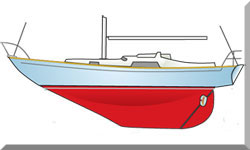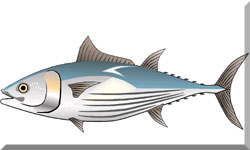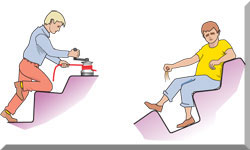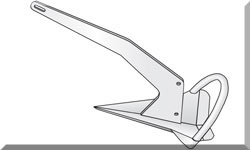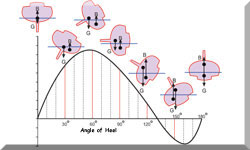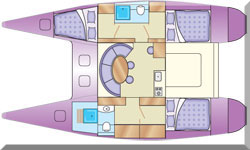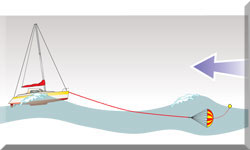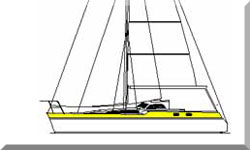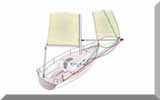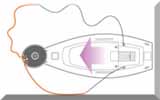- Home
- Mainsail Reefing
The Sailor's Guide to Mainsail Reefing
In a Nutshell...
Getting to grips with mainsail reefing is one of the most important skills a cruising sailor can learn. It's simply the art of making the mainsail smaller to handle stronger winds and bigger seas. The three main ways of doing this are slab reefing (old school but reliable), in-mast reefing (super convenient but with a few trade-offs), and in-boom reefing (the best of both worlds, really). The bottom line is, you need to be able to reduce your sail area safely and efficiently—it's about staying in control, not about being a hero.
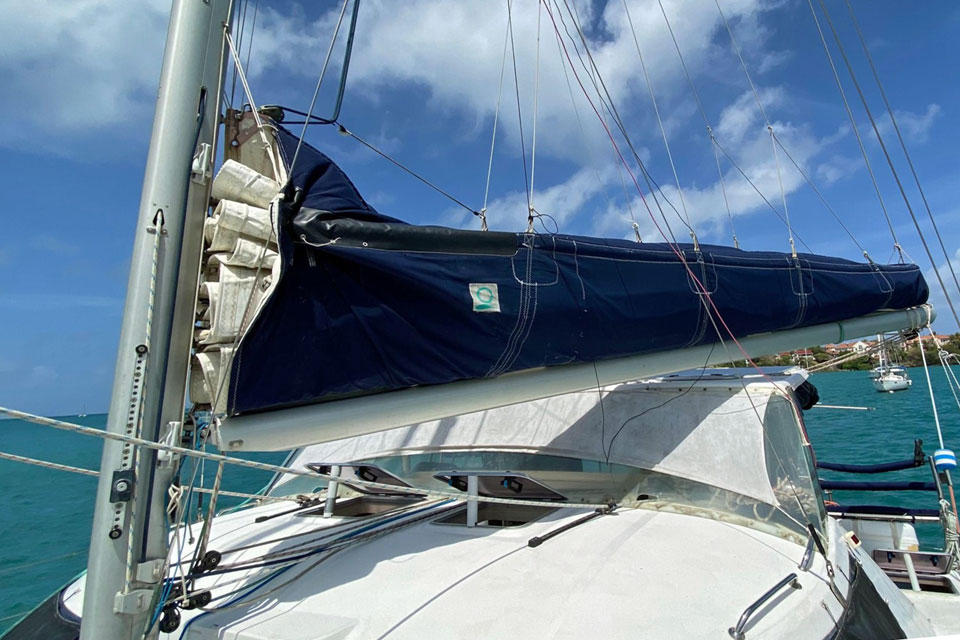 A slab-reefing mainsail contained within a stackpack
A slab-reefing mainsail contained within a stackpackTable of Contents
What are the Main Types of Mainsail Reefing Systems?
If you spend enough time on the water, you'll know that conditions can change in a flash. One minute you're sailing along in a gentle breeze, and the next you're thinking about how to manage a boat that's feeling a bit overpowered. That's where mainsail reefing comes in. It's the key to keeping your boat balanced, stable, and happy. We’ve all been there—when that first big puff hits and you know it's time to act. It's not just a procedure; it's a feeling you get in your gut. Let's get down to the brass tacks and look at how the three most common systems work.
1. Slab (Jiffy) Reefing
I’ve spent countless hours with slab reefing systems on all sorts of boats. It’s a method that has stood the test of time for a reason. It's a manual process where you drop the mainsail a bit to one of a few pre-set points and then secure it at the luff and leech. The loose sail cloth is then bundled up on top of the boom. You can do this with either a single line or a double line system.
A Quick Look at the Pros & Cons:
- Simple & Tough: It’s a beautifully simple system with minimal moving parts. Fewer things to break means more reliability, which is exactly what you want offshore.
- Good Value: It won’t break the bank to install or maintain.
- Sail Shape: This is where it really shines. You can get a much better, flatter sail shape with slab reefing, and that means better sailing performance.
- The Downside: The main drawback is you often have to go to the mast to get the job done. In heavy weather, that can be a real handful and a bit risky.
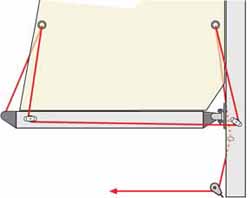 A single-line jiffy reefing system
A single-line jiffy reefing system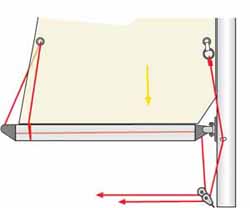 A double-line jiffy reefing system
A double-line jiffy reefing systemHow to Perform Slab Reefing Step-by-Step
There's a rhythm to it, and once you’ve done it a few times, it becomes second nature. But in a building gale, with the spray flying, a simple reef can feel like a major task. The trick is to be methodical and work with your crew.
- Prep the Boat: First things first, get the bow pointing into the wind to take the pressure off the sail. If you're on your own, lock the wheel; if you have crew, get them to hold the boat steady.
- Ease the Controls: Ease the mainsheet to get the boom centred and ease the vang. This takes the load off the sail and lets the boom rise a little, making everything easier.
- Drop the Mainsail: Gently ease the main halyard until the reefing tack cringle is just above the gooseneck. Watch to make sure the sail isn’t snagging on anything.
- Secure the Tack: This is a crucial step. Hook the tack cringle over the reefing horn or tie it off with a line. Make sure it's snug against the mast to maintain sail shape.
- Re-tension the Halyard: Tighten the halyard just enough to put some tension on the luff. You don't want it tight as a banjo string, but you do want it set properly.
- Secure the Clew: Pull in the reefing line at the clew to bring it down to the boom. Get the foot tension right—not too tight, not too loose.
- Tie the Reef Points: Now, gather up all that loose sail and tie it off with the reefing points. Tie them loosely so you don’t put stress on the sailcloth, and whatever you do, never tie them around the boom.
- Trim the Sail: With the new reef set, trim the mainsheet and vang to get the sail shape you want. Now you’re ready to get back to sailing.
2. In-Mast Reefing
In-mast furling is the ultimate in convenience. No one's on deck, and you can reef with the touch of a button or a pull of a line right from the cockpit. The sail furls vertically into a slot in the mast. It's a game-changer for short-handed sailing.
A Quick Look at the Pros & Cons:
- Super Convenient: The big one. No more battling with sail bags or reefing at the mast in a rough seaway.
- Safe: It's incredibly safe because all the work is done from the cockpit.
- The Downside: The sail itself has no battens, which means you lose a lot of sail shape and a bit of performance.
- Prone to Jams: I've seen it happen. A little wrinkle or fold, and the whole thing can get jammed inside the mast, which is a real pain to sort out.
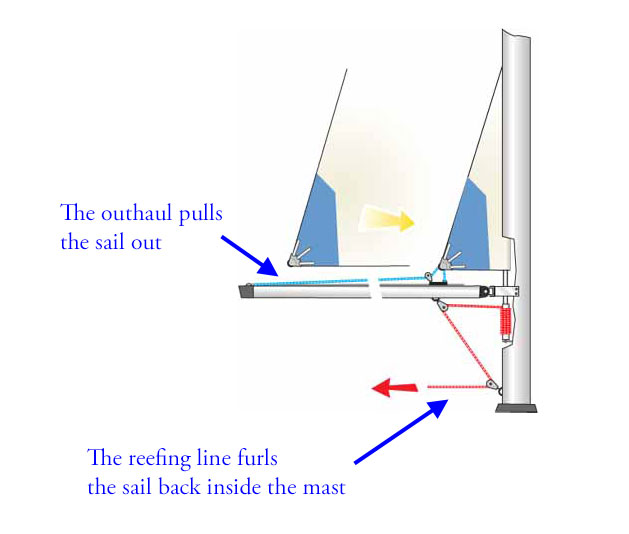
How to Perform In-Mast Reefing Step-by-Step
This is all about a smooth, coordinated effort.
- Prep the Boat: Get on a close reach or head up to the wind to take the load off.
- Ease Controls: Ease the mainsheet and vang, and gradually release the outhaul.
- Start Furling: Pull the furling line (or hit the button) to start rolling the sail into the mast. You’ll need to work the outhaul and furling line together to keep the sail flat as it rolls in.
- Watch It: Keep an eye out for any creases or wrinkles. If you feel resistance, stop immediately.
- Set Sail Area: Just keep furling until you have the right amount of sail left out. A lot of boats have marks on the outhaul line to help you get it just right.
- Secure & Tension: Lock everything off and then tighten the outhaul again to get the foot tension set.
- Trim: Trim the mainsheet and vang and you’re good to go.
3. In-Boom Reefing
In-boom furling is a brilliant compromise. It’s a bit of an upgrade on in-mast, really. The sail rolls horizontally into the boom, and because it’s a wide boom, you can have full-length battens. This means you get the convenience of furling with much better sail shape.
A Quick Look at the Pros & Cons:
- Great Sail Shape: This is the key difference. You can still have a performance sail while enjoying the convenience of furling.
- Cockpit Controlled: Just like in-mast, you can do all the work from the safety of the cockpit.
- Complex: It’s a more complex bit of kit, which means more to go wrong and more maintenance.
- Pricey: It’s not cheap to install.
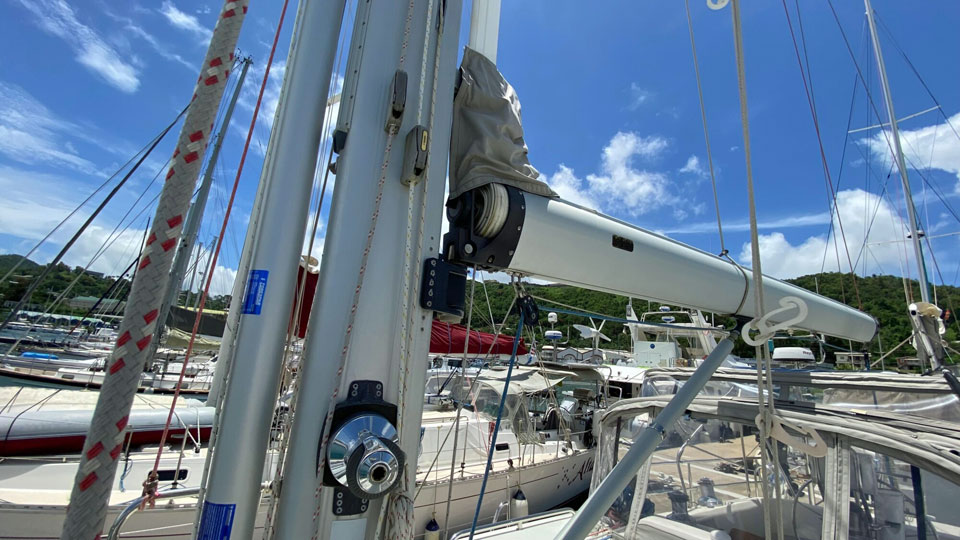 An in-boom furling/reefing system
An in-boom furling/reefing systemHow to Perform In-Boom Reefing Step-by-Step
This is a smooth, delicate dance between the halyard and the furling mechanism.
- Prep the Boat: Sail on a close reach—just enough wind to keep the sail from luffing, but not so much that it's difficult to manage.
- Ease Sail Controls: Ease the mainsheet, vang, and halyard. You need a little slack to let the sail roll in smoothly.
- Engage the Roller: Use the handle or motor to start rolling the sail into the boom. You need to ease the halyard at the same time to let the sail go down.
- Watch the Sail: Keep an eye out for any creases or uneven rolling. Stop and adjust if you need to.
- Set the Reef: Keep rolling until you have the right sail area for the conditions.
- Secure & Trim: Lock the boom and then tighten the halyard and outhaul to get the tension right on the sail.
- Get Back to Sailing: Trim the mainsheet and vang and check how the boat feels.
A Quick Comparison of Mainsail Reefing Systems
Choosing a system is a big decision and it's a trade-off between performance, convenience, and cost. Here’s a table to help you compare them.
| Feature | Slab (Jiffy) Reefing | In-Mast Reefing | In-Boom Reefing |
|---|---|---|---|
| Sail Shape & Performance | Excellent. Flat, efficient sail. | Compromised. Sail lacks battens. | Good. Can use full or vertical battens. |
| Ease of Operation | Manual, requires crew on deck. | Very easy, cockpit controlled. | Very easy, cockpit controlled. |
| Safety | Lower in heavy weather (due to deck work). | Highest. No deck work required. | High. Most work done from the cockpit. |
| Cost | Low initial & maintenance cost. | High initial & maintenance cost. | High initial & maintenance cost. |
| Reliability | Very high. Simple mechanics. | Lower. Prone to jams. | Lower. Mechanically complex. |
Common Problems & Troubleshooting
Even with a well-maintained system, things can go wrong. I've had my share of problems over the years, and knowing how to troubleshoot them is half the battle.
Sail Jams
- Why it Happens: The most common culprit is uneven furling. The sail bunches up inside the mast or boom because you weren't easing the halyard and outhaul at the same speed.
- What to Do: The golden rule is: never force it. Stop immediately. Try gently easing the halyard or outhaul to relieve the tension. If you can, try to manually free the bunched-up part. Just remember, brute force will only make it worse.
Too Much Friction
- Why it Happens: Old, worn-out lines and blocks that aren’t running freely can make reefing a real chore.
- What to Do: Give your blocks a check; make sure they’re spinning freely. Consider upgrading your lines to a better, low-stretch material and make sure the lines are running as cleanly as possible back to the cockpit.
Preventing Sail Damage
- Why it Happens: Careless reefing can lead to chafe and tears.
- What to Do: Never tie the the reefing points tightly or around the boom. Their only job is to gather the loose sail, not to take the load. Snd get into the habit of checking the sail and rigging regularly. Look for any signs of wear where the sail meets the reefing points or where the lines run over blocks.
Summing Up
Picking the right mainsail reefing system is a big decision for any cruising boat. It's about finding the right balance between how much you're willing to spend, how much performance you want, and how easy you want it to be. While in-mast and in-boom systems are a godsend for ease and safety, the simplicity and sheer reliability of slab reefing still make it a popular choice. For a comprehensive overview of all types of sail reduction, including headsail reefing and storm tactics, you may find our pillar page, Reefing a Sail: The Ultimate Guide to Control & Safety at Sea, to be a valuable resource. At the end of the day, no matter what system you have, a well-rehearsed plan is what will keep you safe and confident on the water.
This article was written by Dick McClary, RYA Yachtmaster and author of the RYA publications 'Offshore Sailing' and 'Fishing Afloat', member of The Yachting Journalists Association (YJA), and erstwhile member of the Ocean Cruising Club (OCC).
Frequently Asked Questions
When should I reef my mainsail?
When should I reef my mainsail?
There’s no magic number. It’s more of a feel thing. When the boat starts to feel overpowered, you’re heeling too much, or it’s becoming a real effort to hold your course, it's time to reef. It's always better to put a reef in too early than to wish you had later.
Can I reef without a stackpack?
Can I reef without a stackpack?
Yes, you can, but it’s a proper faff. A stackpack or lazyjacks make life so much easier by corralling the loose sailcloth and stopping it from blowing all over the deck.
What's the deal with single-line vs. double-line slab reefing?
What's the deal with single-line vs. double-line slab reefing?
A single-line system uses one line to pull down and secure both the tack and the clew. A double-line system uses separate lines for each, which gives you a bit more control but adds another line to the cockpit.
How do I stop my in-mast system from jamming?
How do I stop my in-mast system from jamming?
The number one reason for a jam is not easing the lines smoothly. Get into the habit of a steady, even pull on the furling line while easing the outhaul smoothly.
Can I change my boat's reefing system?
Can I change my boat's reefing system?
You can, yes. Going from a slab reefing system to a furling one is a major job, though. It's a lot of money and effort, so it’s not something you’d do on a whim.
Recent Articles
-
Hans Christian 43: Classic Bluewater Cruiser & Liveaboard Sailboat
Dec 10, 25 04:37 AM
Explore the Hans Christian 43: a legendary heavy-displacement, long-keel sailboat. Read our in-depth review of its specs, design ratios, and suitability for offshore cruising and living aboard. -
Planning Your Sailboat Liveaboard Lifestyle: An Ocean Sailor's Guide
Dec 06, 25 05:18 AM
Seasoned sailors share their methodical risk analysis for planning a secure Sailboat Liveaboard Lifestyle, covering financial, property, and relationship risks. -
Marine Cabin Heaters: The Expert’s Guide to Comfort & Safety at Sea
Dec 05, 25 06:52 AM
Choose the best Marine Cabin Heaters for your vessel. Expert advice on diesel, paraffin, and hot water systems for year-round cruising comfort.


